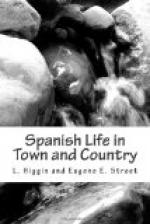POPULAR AMUSEMENTS
Nothing strikes one so much in studying the popular customs and pleasures of Spain as the antiquity of them all. Constantly one finds one’s self back in prehistoric times, and to date only from the days when Spain was a Roman province is almost modernity. No one can travel through Spain, or spend any time there, without becoming aware that, however many other forms of recreation there may be, two are universal and all-absorbing in their hold on the widely differing provinces—dancing and the bull-ring. In the Basque Provinces, the national game of pelota, a species of tennis, played without rackets, is still kept up, and is jealously cultivated in the larger towns, such as Vitoria, San Sebastian, and Bilbao. In Madrid at the present time it is played in large courts built on purpose, and attracts many strangers. To view it, however, as a national sport, one should see it in some of the mountain villages, where it is still the great recreation for Sundays and religious fiestas. The working-classes also play at throwing the hammer or crowbar. This is more especially the case in the Northern provinces, where the workmen are a sound, healthy, and sober race, enjoying simple and healthy amusements, and affording an excellent example to those of countries considering themselves much more highly civilised.
Pigeon-shooting, which was a great favourite with the late King Alfonso XII., and was made fashionable among the aristocracy in Madrid by him, is a very old sport—if it deserves the name—among the Valencians. Near La Pechina, at Valencia, where the great tiro de las palomas takes place, was found, in 1759, an inscription: Sodalicium vernarum colentes Isid. This, Ford tells us, was an ancient cofradia to Isis, which paid for her culto. Cock-fighting is still practised in most of the Spanish towns, as well as in Valencia, the regular cock-pits being constantly frequented in Madrid; but it is looked upon as suited only to barrio’s bajos, and is not much, if at all, patronised even by the middle classes. It is said by those who have seen it to be particularly brutal; but it was never a very humanising amusement when practised by the English nobility not such a very long time back.
Whatever amusements, however, may be popular in the towns, or in particular provinces, the guitar and the dance are universal. So much has been written about the Spanish national dances that an absurd idea prevails in England that they are all very shocking and indecent. It is necessary, however, to go very much out of one’s way, and to pay a good round sum, to witness those gypsy dances which have come down unchanged from the remotest ages. As Ford truly says, “Their character is completely Oriental, and analogous to the ghawarsee of the Egyptians and the Hindoo nautch.” “The well-known statue at Naples of the Venere Callipige is the undoubted representation of a Cadiz




